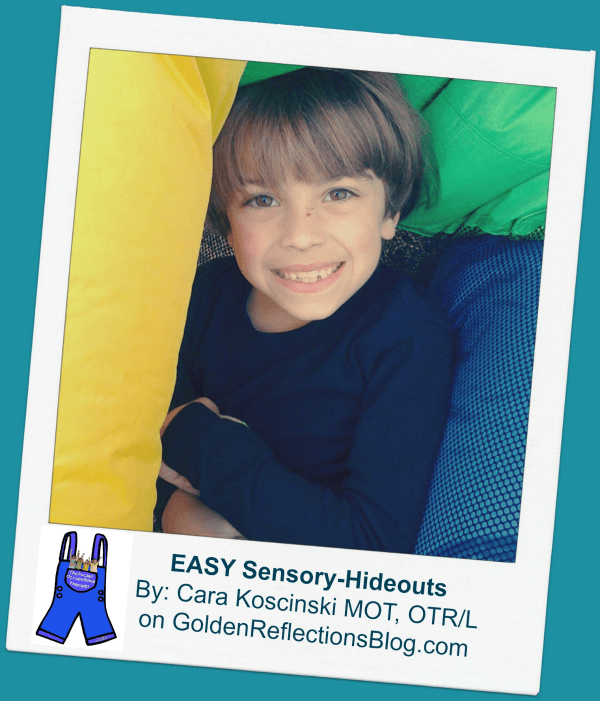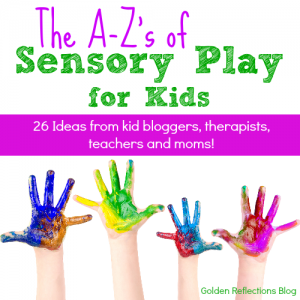E is for Easy Sensory Hideouts
Affiliate and Referral links are used below to promote products I love and recommend. I receive a commission on any purchases made through these links. Please see my disclosure policy for more details. As an Amazon Associate, I earn from qualifying purchases.
Today I am very excited to introduce Cara from The Pocket Occupational Therapist as part of the A-Z's of Sensory Play for Kids Series. She is going to be sharing with you all the benefits of sensory hideouts for kids with sensory needs.
First of all, I want to say Thank You to Heather for blessing me with the privilege of writing here!
Hideouts have been important to kids throughout the ages. Many backyard clubhouses, treehouses, and princess castles grace backyards across our great country. The need for a space in which a child can go to regulate or calm when sensory overload happiness is becoming more common.
According to the SPD Foundation, 1 in 20 children experience Sensory Processing Disorder. Oftentimes, children react in different ways to sensory input. Some under-respond and need more activity, while others over-respond and need a space of comfort and tranquility. It can be difficult to help children to find that “just right” level. Many times, anxiety results and a breakdown is possible. Since many children with special needs have difficulty speaking or even realizing that they need a break, it’s our job to help.
What Is a Sensory Hideout?
So what IS a sensory “hideout?” There are many reasons kids require a break. Most often, it’s due to overstimulation in the child’s environment. Children simply become overwhelmed and need a cozy place in which to cool down. Sensory corners exist in schools, homes, and clinics everywhere but knowing how to create the space is important. Many caregivers dream of awesome sensory areas, but quickly become overwhelmed with sticker shock when looking through sensory-based products.
As an occupational therapist (OT) my job is to find creative ways to adapt a child’s environment. So, I’ve outlined ideas for you:
- Where IS the space? Consider tents, blankets draped over tables, or isolate a side of the room with curtains. The space should be away from noise and busy areas. PVC piping can be made into a structure that fits uniquely into a specific area. If you’re crafty, place pool noodles over the PVC pipe and sew fabric around to make your own custom tent area. Kiddie pools and ball pits are great options for smaller children. They provide a safe area with clear boundaries.
- Add pillows, bean bags, blankets, floor mats, and weighted pads/blankets. Some parents purchase dense foam and sew it into pillowcases. Lycra fabric can be wrapped around the child for an extra cozy feeling.
- Lighting is SO important when talking about a sensory hideout. Add some holiday lights to the area or a flashlight so that the child is able to control the light himself. Dim lighting is generally calming. LED lights are great since they can be adjusted to various colors and patterns. Always avoid fluorescent lighting if possible.
- Provide feelings books or make your own chart so that children can learn to identify feelings of frustration, anger, etc. Some children benefit from drawing pictures so add some crayons and paper.
No one space is right for every child so it’s important to ask your child for input. Decide together those colors which are calming. Place toys in the area that are soothing. Discuss when it’s time to use the sensory space and encourage kids to try the space out during calm times. Remember that the BEST sensory space is the one you create together.
Cara Koscinski earned her Master's degree in Occupational Therapy in 1997. She is a homeschooling mother to her own children with special needs. Cara provides occupational therapy services, advocacy, and consultations as The Pocket Occupational Therapist. Cara enjoys speaking to therapists, teachers, and special needs organizations across the US. Her award-winning books, The Pocket Occupational Therapist for Caregivers of Children with Special Needs and The Special Needs SCHOOL Survival Guide for autism, SPD, ADHD, learning disabilities are available on her website at www.PocketOT.com
For more information on sensory hideouts check out my post “Making Your Own Sensory Room At Home.”
For more sensory ideas, follow my Sensory Fun Pinterest board.

Heather Greutman, COTA
Heather Greutman is a Certified Occupational Therapy Assistant with experience in school-based OT services for preschool through high school. She uses her background to share child development tips, tools, and strategies for parents, educators, and therapists. She is the author of many ebooks including The Basics of Fine Motor Skills, and Basics of Pre-Writing Skills, and co-author of Sensory Processing Explained: A Handbook for Parents and Educators.



